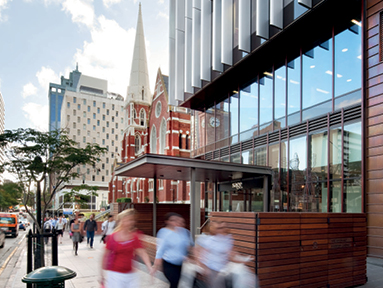Why design or build a green commercial building?

![]()
The benefits of designing & building green commercial buildings
The business case for designing and building green buildings continues to stack up. Green buildings deliver a range of business benefits including:
> Attract tenants
> Time and resource efficiency
> Environmental benefits
> Market recognition
|
Higher return on investment
|
 |
![]()
Green proves gold for Pixel Building
|
||
Purchasers are increasingly attracted to unique, innovative and sustainable buildings.Daniel Grollo – Former Chief Executive Officer, Grocon |
 |
![]()
Attract tenants
Greener buildings have a competitive edge and can help to attract prospective tenants.
- The GBCA’s Valuing Green (2008) report found that green buildings attract better quality tenants, such as government and ‘top tier’ corporates with stable businesses and strong commitments to corporate social responsibility.
- World Green Building Council’s Business Case for Green Building (2013) found that buildings with a green rating report an occupancy rate increase of up to 23%. The higher the rating, the higher the rental premium – with an average 3% increase in rent for each additional level of certification.
- Colliers International’s Office Tenant Survey (2012) found that 95% of tenants want to be in a green building, up from 75% two years earlier. ‘Green space’ is one of the top four attributes tenants look for for – along with bike racks, childcare facilities and a gym.
- CBRE’s Do Green Buildings Make Dollars and Sense? (2009) found that that green buildings have 3.5% lower vacancy rates and 13% higher rental rates than the wider market.

![]()
| For Australand, the driver for achieving a Green Star rating for The Key Spec 1 building in Melbourne was simple – the advantage it can provide in securing tenants. Read more The Key Spec 1 case study. |
 |
![]()
Time and resource efficiency
|
 |
![]()
Environmental benefits
Building green is a clear expression of commitment to the environment.
- The Value of Green Star: A decade of environmental benefits (2013) finds that, on average, Green Star-certified buildings:
> Use 66% less electricity than average Australian buildings
> Produce 62% fewer greenhouse gas emissions than average Australian buildings<
Contact:
Rachael McGinley
Senior Manager - Strategy & Development
Green Building Council of Australia
Phone: 02 8239 6291
Email: rachael.mcginley@gbca.org.au
In this section
- Why design or build a green commercial building?
- Why design or build a green residential building?
- Why design or build a green school?
- Why design or build a green hospital?
- Why design or build a green public building?
- Why own a green commercial building?
- Why own a green residential building?
- Why own a green school?
- Why own a green hospital?
- Why own a green public building?
